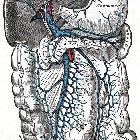portal venous system
The portal venous system refers to the vessels involved in the drainage of the capillary beds of the GI tract and spleen into the capillary bed of the liver.
Blood flow to the liver is unique in that it receives both oxygenated and deoxygenated blood. As a result, the partial pressure of oxygen (pO2) and perfusion pressure of portal blood are lower than in other organs of the body. Blood passes from branches of the portal vein through cavities between hepatocellular sinusoids. Blood also flows from branches of the hepatic artery and mixes in the sinusoids to supply the hepatocytes with oxygen. This mixture percolates through the sinusoids and collects in a central vein which drains into the hepatic veins. The hepatic veins subsequently drain into the inferior vena cava.
Siehe auch:
und weiter:

 Assoziationen und Differentialdiagnosen zu portal venous system:
Assoziationen und Differentialdiagnosen zu portal venous system:


